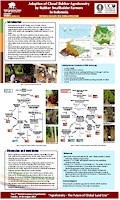| Poster |
 |
|
| Title | Adoption of Clonal Rubber Agroforestry by Rubber Smallholder Farmers in Indonesia | | Author | Dudi Iskandar, Laxman Joshi, Alison Loveridge and Bruce Manley | | Year | 2009 | | Publisher | World Agroforestry Centre - ICRAF, SEA Regional Office | | City | Bogor, Indonesia | | Call Number | PO0200-09 | | Notes | The 2 World Congress of Agroforestry Nairobi, 24-28 August 2009 |
|
| Abstract: |
| � Indonesia has the world’s largest area of rubber (Hevea brasiliensis) plantations (3.5 million ha) and is the world’s second largest natural rubber producing country (2.7 million tons in 2007); 83% rubber area managed by smallholder farmers (<5 ha
fields)
� 64% rubber area still under traditional mixed system using unselected rubber seedlings (often called jungle rubber), with low latex productivity but provide multiple products and services.
� Intensive monoculture rubber with high yielding rubber clones offers higher latex productivity but requires high capital and labour input.
� Improved Rubber Agroforestry System or RAS developed and promoted by the World Agroforestry Centre (ICRAF) incorporates clonal rubber in traditional agroforestry setting improves latex productivity while maintaining benefits of traditional system.
� RAS technology is becoming popular among smallholder rubber farmers, but its adoption is still slow and uneven; farmers cite multiple reasons for this. |
|
|
Download file(s): Click icon to download/open file.
|
| |
File Size |
Description |

|
1,490 KB |
Softcopy |
|
|
GRP 2: Maximizing on-farm productivity of trees and agroforestry systems
|
| Viewed in 2038 times. Downloaded in 738 times. |